Sneath Glass Company
The Sneath Glass Company /sniːθ/ was an American manufacturer of glass and glassware. After a brief 1890s startup in Tiffin, Ohio, the company moved to Hartford City, Indiana, to take advantage of the Indiana Gas Boom.[1] The small city was enjoying the benefits of the boom, and could provide natural gas as an energy source for manufacturers.[2] Sneath Glass was one of many glass manufacturers that moved to the region, and became Hartford City's second largest employer.[3]
 | |
| Industry | Glass |
|---|---|
| Predecessor | Tiffin Glass Company |
| Founded | 1892 |
| Defunct | 1952 |
| Headquarters | Hartford City, Indiana |
Area served | Worldwide |
Key people | Ralph Davis Sneath, Henry Crimmel |
| Products | Lantern globes Glassware Specialty glass |
| Revenue | USD $1.055 Million (1951) |
Number of employees | 144+ (1952) |
Among the original owners, Ohio businessman Ralph Davis Sneath provided capital and financial knowledge—and his family is the company's namesake. Sneath was president of the firm when it moved to Indiana. Henry Crimmel, who already had over 25 years of glassmaking experience when he joined the company, provided the manufacturing expertise after the firm's reorganization.[4][Note 1] Following this reorganization, Alva Clyde Crimmel (Henry's son) was the firm's secretary, while John W. Geiger served as treasurer. These four members of the management team were the company's owners when it moved to Indiana.[1]
In Indiana, the company's main products were initially lantern globes and founts (which held the lantern's fuel), and railroads were its major customers.[1] As demand for lanterns declined during the beginning of the 20th century, Sneath evolved to be a maker of glassware for portable kitchen cabinets, such as those made by Sellers and the Hoosier Manufacturing Company.[6] Eventually, portable kitchen cabinets lost their popularity after new houses began utilizing built-in cabinetry. Sneath transitioned to be a maker of a new group of wares—glass products for refrigerators.[7] While lanterns, kitchenware, and refrigerator products were the major goods manufactured by the company during its existence, it also made a wide variety of additional merchandise. Aquariums, lenses, and mailboxes were also among the glass products made by the company.[7] Sneath was also an early manufacturer of heat-proof glass.[7]
After World War II, Sneath's major products began to become obsolete because of the plastics industry. Unlike earlier in the century, the company did not transition to a new major product when demand for its portfolio of manufactured goods subsided. Management did not adapt to competition from the plastics industry, faced a shrinking market for its goods, and could not raise prices due to post-war government price controls.[8] The factory closed in 1952 after a work stoppage led by the local labor unions.[9]
Early years
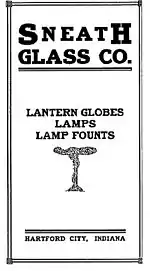
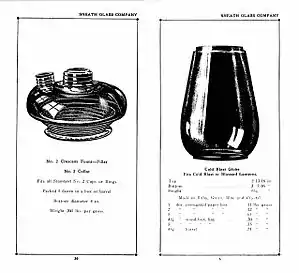
The Tiffin Glass Company was established in 1889 in Tiffin, Ohio.[1] On January 22, 1892, the company was purchased by Samuel B. Sneath, Ralph D. Sneath, and John. W. Geiger—and renamed Sneath Glass Company. Production began in February, and their main products were lantern globes and tumblers.[Note 2] After a reorganization and the destruction of its Tiffin works by fire, the company was lured to Hartford City, Indiana.[1][13] Located in East Central Indiana, Hartford City offered free natural gas and land.[14] The East Central Indiana area was enjoying an economic “boom” period at that time caused by the discovery of natural gas.[Note 3] The first Sneath Glass plant in Hartford City was located on the north side of town.[19] Production began in September 1894, and the company already had orders for 6 months of work on the first day of operation.[20]
Following the company's reorganization, the firm's officers were Ralph Davis Sneath, president; John. W. Geiger, treasurer; Alvie Clyde Crimmel, secretary; and Henry Crimmel, plant manager.[1] These four men were also the owners of the company, each owning equal shares of its stock. The board of directors consisted of the four owners plus Ralph's father, Samuel B. Sneath. The Sneaths came from a family of prominent businessmen from Tiffin, Ohio,[21] and the Crimmels came from a family of glassmakers.[22] Ralph Sneath also became involved in a grain dealership, railroading, and banking. He eventually became president of the Commercial National Bank of Tiffin, Ohio, and also president of the Ohio Banker's Association.[23] Civil War veteran Henry Crimmel brought over 25 years of glass making experience to the company, having learned and sharpened his skills in Bellaire, Fostoria, and Tiffin, Ohio. Henry's brothers, Johannes (a.k.a. John) and Jacob, worked in glassmaking—and Jacob also helped found the American Flint Glass Workers' Union.[24] Both Henry and Jacob Crimmel were considered key craftsmen in the early days of the Fostoria Glass Company.[25] While the Sneaths remained in Tiffin to oversee their many business interests, the Crimmels and Tiffin businessman J. W. Geiger moved to Hartford City.
Originally, Sneath Glass made kerosene lantern globes and the founts that held the lantern's fuel. Ruby, green, and blue globes were a specialty.[26] At one time, Sneath Glass was one of only three factories in the United States that made copper ruby globes. Major customers of lantern globes were railroads and ships.[1] Sneath globes were also used during the construction of the Panama Canal.[27]
By 1897, the company had over 60 employees.[28] Although plant manager Henry Crimmel was known for his craftsmanship, he was also mechanically inclined. The Sneath plant had a unique system of air hoses that would allow glass blowers to quickly finish glassware that was started without the aid of machinery, enabling the skilled workers to achieve a much higher production rate.[6] Henry Crimmel received a patent in 1904 for a “Glass Drawing Machine” that was an improvement for glass blowing and prevented irregularities in the glass.[29]
In 1905, Sneath Glass moved to the Jones plant of the American Window Glass Company, located on Wabash Avenue in the west side of Hartford City. The Wabash Avenue site had direct access to a railroad, and was close to Washington Street, which eventually became part of Indiana State Road 26, now the major east-west highway through the city. The Jones plant was quickly remodeled, and both operations and headquarters were moved to that site. This location became the permanent home of Sneath Glass Company.
John W. Geiger, part of the original company ownership and management, retired in 1907 and moved back to Tiffin, Ohio. He died at his home in Tiffin on June 23, 1915, at the age of 74 years.[30] Another original investor, Samuel B. Sneath, died earlier in the same (1915) year, on January 7.[31]
Transition from globes to other products
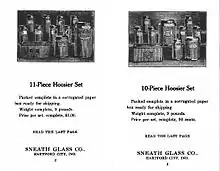
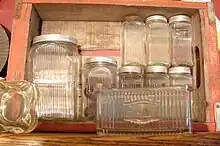
Originally, the company devoted its production exclusively to lighting and lantern-related products such as lantern globes and founts. It made more globes than any two companies combined.[1] Several factors contributed to the need for a transition from globe manufacturer, and all were related to declining demand. First, around the beginning of the 20th century, electrification and the incandescent light bulb began replacing oil lamps, causing less need for lamp globes and fonts in cities.[32] A few decades later, railroads (major customers for globes) stopped expanding. Railroad route miles peaked around 1916, and railroad employees peaked around 1920.[33] Since the railroad industry was shrinking, its demand for lantern globes would diminish. Finally, in the 1930s, rural electrification decreased farmers' need for oil lamps.[34]
By 1899, the company was listed as the only manufacturer of semaphore globes and bulls eye lenses.[35][36] However, the company was diversifying from its lighting products portfolio with fruit jars and glassware.[Note 4] Three sizes of Mason jars were being hand blown by 1908. The Sneath jars were said to be "superior and more durable than machine made jars."[41] Around the same time, the company began making glass canisters for kitchen cabinet companies, including the Hoosier cabinet made by Hoosier Manufacturing Company.[6] This began the gradual (but important) transition from manufacturer of globes to manufacturer of glass products for portable kitchen cabinets. Cabinet products included salt and sugar bins, spice jars, and coffee and tea jars.[Note 5] From 1914 to 1916, management patented dispensing caps,[42] a dispensing jar,[43] and a bracket for supporting dispensing bins used in kitchen cabinets.[44]
Henry Crimmel suffered a stroke in 1916, and died about one year later.[5][45] Henry's son (and company co-founder) Alva Clyde (a.k.a. Alvie or Clyde) Crimmel took more management responsibilities at that time, and by 1920 his title was Vice-President and Treasurer. Clyde's oldest son, Henry Hays Crimmel, joined the company's management in 1918, focusing on sales.[6] Henry Hays had been working at Sneath since he was a child, and was very familiar with the company's products. Child labor was common in glass factories during the 19th century and early 20th century. The elder Henry Crimmel was fined $11.95 in 1901 by the state of Indiana for employing children under the age of 14.[46][Note 6]
The company used its experience with lighting and lenses to assist the United States government during World War I. Almost 10 percent of Sneath's production was devoted to a contract with the United States Navy to manufacture signal and masthead lights. Red, green, and white lights were produced for Navy ships.[48]
By 1918, the company's products (in addition to the lenses and lamps) were lantern globes, colored and crystal specialties, and food preservation ware such as canisters and fruit jars.[49] Around 1920, the company began making an interesting (but less important) product—a wall-mounted mail box. These mailboxes were made of glass, enabling one to easily see if mail had been delivered. Sneath employee William Chapman, working under the supervision of Ray Pruden, was granted a patent for the glass mailbox in 1921.[50][Note 7] Ray Pruden was superintendent of the factory, assuming that title after Henry Crimmel's stroke. William Chapman was a well-known glass blower who also secured a patent for an ash tray.[53] Employees of the company also patented other products, including a drawer pull,[54] a caster for furniture,[55] a newspaper receptacle,[56] and a chick feeding fount.[57] Years later, the glass mailbox was shown in Popular Mechanics magazine.[58]
Sneath Glass continued making glassware for kitchen cabinet manufacturers such as Hoosier and Sellers, and the 1920s were peak years for that cabinet style. Sneath management also patented more of its products used in kitchen cabinets, such as a sugar bin and a holder for condiment jars.[59] [60] The company also continued to improve its manufacturing process, as two employees were granted a patent for a means to remove glass from molds.[61]
|
The Sneath S Mark 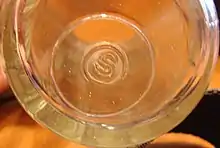 Sneath Glass Company mark on spice jar Originally, glassware made by the Sneath Glass Company could easily be identified by an "S" on the bottom of the product, such as on the spice jar shown in the adjacent photograph. Eventually, the "S" mark was discontinued. The "S" was eliminated to save mold–cleaning time. When the molds for the glassware became unclean, they would need to be scrubbed. In addition to the time spent scrubbing, the "S" on the mold would, in effect, eventually be polished off the mold—making replacement necessary. By not using the "S" mark, scrubbing time was eliminated, and molds would last longer. The problem with this cost-saving change was that it did not promote the Sneath brand. Sneath products lost their brand recognition, became difficult to identify, and competitors could make similar products that customers could not differentiate from Sneath's. |
 Child laborers in an Indiana glass works
Child laborers in an Indiana glass works Collection of glassware made by Sneath Glass Co.
Collection of glassware made by Sneath Glass Co. Mailbox made by Sneath Glass Co. displayed in a museum
Mailbox made by Sneath Glass Co. displayed in a museum Jar and rolling pin manufactured by Sneath Glass Co.
Jar and rolling pin manufactured by Sneath Glass Co. Front of booklet listing kitchen glassware made by Sneath Glass Co.
Front of booklet listing kitchen glassware made by Sneath Glass Co.
The Great Depression and World War II
In 1930, management consisted of Ralph D. Sneath, president; Alvie Clyde Crimmel, vice president; Henry Hays Crimmel, treasurer and general manager; Harry C. Hill, secretary and sales manager; and Ray Pruden, factory manager.[62] During the Great Depression of the 1930s, Sneath kept much of its workforce employed by shortening shifts. This kept the company from losing its skilled workers, and enabled more people to be employed. The glass business was thought to have one advantage during difficult economic times: people purchased glass products rather than metal products.

In addition to their kitchen glassware products, Sneath began to make refrigeration products. Between 1933 and 1941, management secured at least six patents related to mechanical refrigerators.[Note 8] At one time, Sneath Glass produced almost 90 percent of the glassware used in consumer refrigerators in the United States.[7] This glassware was produced under the name of the appliance manufacturer, and included the major manufacturers of the time. Some of the consumer refrigeration products produced were defroster trays, cold water pitchers, and butter dishes. Additional products made by Sneath included sundae dishes, ink wells, fish tanks, and battery jars used by farmers' windmills.
Like the company's transition from lantern globes to glassware for kitchen cabinets, the transition to refrigerator products was important for the company's survival. By the mid-1930s, the Hoosier style cabinets, many of which contained glassware made by Sneath Glass, had lost their popularity. New houses typically contained built-in cabinetry.[69]
Although the company had transitioned to refrigerator products as a focal point, it still made other merchandise. One product was the company's own version of borosilicate glass, which was called "heat proof" glass. This glass could be moved from a refrigerator to an oven without breaking from the extreme temperature change. Heat proof glass was used for ovenware and coffee makers—and during World War II, it was used in searchlight products.[70] Unfortunately, the Sneath version of borosilicate glass, like the Sneath brand, was not promoted.
In 1940, millionaire Ralph Sneath died shortly after receiving severe injuries in an automobile accident, and the last of the founders, Alvie Clyde Crimmel, became chief executive.[71][72] Although Sneath did not spend much time at the glass plant, he was well liked and watched the company finances. Despite this loss, an aging workforce, and an aging infrastructure, the company continued to have talent both in the manufacturing process and creatively. Employee James A. Lewis received three patents related to glassmaking during the early 1940s, and master glass blower Bill Claytor was well known in the industry.[Note 9] Mr. Claytor became renowned in Hartford City because of the hand-blown Christmas gifts he made from a small furnace in the garage of his home.[6]
During World War II, the company made water-tight globes and lenses for search lights. Additional consumer products included glass irons, skillets, and even kitchen sinks.[8] The 1946 management team was A. C. Crimmel president; Henry Hays Crimmel, Vice President; H.C. Hill, Secretary and Sales Manager; S.B. Sneath Jr., Treasurer; John Richard Crimmel, Assistant Treasurer and Purchasing Agent; and Ray Pruden, Superintendent. Refrigeration products continued to be the most important segment of the product portfolio at that time.
The end of Sneath Glass
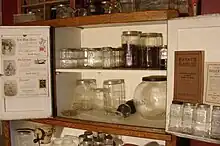
In the early 1950s, glass manufacturers faced competition from the new plastics industry. Glass companies needed to change with the times or face extinction, and Sneath Glass did not make enough changes. Refrigerator parts such as drip plates were being made of plastic instead of glass, and the company declined opportunities in both fibreglass and plastics. By making glassware mostly for other companies, Sneath had lost brand recognition, and it did not promote the Sneath brand or products such as its heat proof glass. Competitors making ovenware products had gained much better brand recognition. This meant that the company faced declining demand for its top two categories of products.
During 1952, the nation had a system of price controls that attempted to control post-war inflation. Workers at the Sneath Glass plant held a strike (the first ever for Sneath Glass), demanding better wages and fringe benefits.[9] Unfortunately, even if the competitive market would accept higher prices for Sneath glassware, the nation's Price Stabilization Board would not allow Sneath to increase prices— and the company was already losing money. The plant was closed, and approximately 125 families lost a source of income. The remaining company founder, A.C. Crimmel, died within two years.[76] Ironically, Henry Crimmel helped found a company that lasted 60 years, and his brother Jacob helped found a union that contributed (along with management) to the company's demise.
In 1953, Indiana Glass Company purchased controlling interest of the Sneath works.[77] The Indiana Glass works was located in an adjacent county, in Dunkirk, Indiana. This acquisition enabled the company to offer Sneath's heat proof glass as one of its many glassware products. Production at the Hartford City plant was restarted briefly, but eventually halted. In 1957, the Hartford City plant was sold to Canton Glass Company of Marion, Indiana.[Note 10]
Notes and references
- Notes
- Henry Crimmel is incorrectly identified as Harry Crimmel in the Hartford City Illustrated book.[1] He was identified as Henry Crimmel in his 1917 obituary.[5]
- The purchase of the Tiffin Glass plant by the Sneaths is described in the March 15, 1892, edition of China, Glass & Lamps, which is quoted in a set of papers held by the Rakow Research Library.[10][11] The same article is partially quoted in a glassware identification book, which also notes that the Tiffin Glass Company purchased by the Sneaths is not the same Tiffin Glass Company that was the successor to the U.S. Glass Company.[12]
- The original East Central Indiana gas discoveries were made in 1886 in the communities of Eaton and Portland, which are 8 and 22 miles, respectively, from Hartford City.[15][16] Successful wells were drilled in Hartford City during the following year.[17] Hartford City also had two railroad lines, one running north-south and one running east-west.[18]
- An 1899 directory of products manufactured in the United States lists the following products manufactured by Sneath Glass Company: fancy colored glass-ware,[37] fruit jars,[38] globes and shades,[39] lantern globes,[35] semaphore globes,[35] glass smoke bells,[40] and bulls eye lenses.[36]
- Some of the Sneath's kitchen cabinet products for Hoosier cabinets are shown in the brochure displayed herein.
- There is a high probability that the elder Henry Crimmel also began his glassmaking career as a child laborer, since his brother Jacob is known to have begun working in a glass plant at the age of 13.[47]
- Although the local newspaper listed both Ray Pruden and William Chapman as the patentees of the glass mailbox, both glass mailbox-related patents from that period list only William Moses Chapman as the inventor.[51][52]
- Employees of Sneath Glass Company had at least six patents related to interiors of refrigerators. Three patents were granted in 1933.[63][64][65] Three more were granted in 1934, 1940, and 1941.[66][67][68]
- Sneath Glass employee James Lewis received three patents during the 1940s. All three patents were related to the mechanized production of glassware.[73][74][75]
- The sale of the Sneath Glass plant to Indiana Glass, and then to Canton Glass, is described in a set of papers held by the Rakow Research Library.[11]
- References
- Unlisted (Hartford City Illustrated) 1896, p. 18
- Unlisted (Hartford City Illustrated) 1896, p. 3
- Indiana Department of Inspection 1902, p. 57
- Crimmel 2000, p. 3
- "H. Crimmel Drops Dead on Street". Hartford City News. 1917-10-10. p. 1.
- Crimmel 2000, p. 4
- Crimmel 2000, p. 5
- Crimmel 2000, p. 6
- "What's Wrong At Sneath?". Hartford City News Times. 1952-10-02. p. 2.
- China, Glass & Lamps 1892
- "[Collection of papers], 1892-1958". Corning Museum of Glass, Rakow Research Library. Retrieved 2012-05-27.
- Bredehoft & Sanford 1999, p. 183
- "Losses By Fire" (PDF). The New York Times. 1894-03-15.
The Sneath Glass Works was burned this afternoon.
- Blackford County Historical Society (Ind.) 1995, p. 6, column 5
- "Indiana's Natural Gas Boom". The American Oil & Gas Historical Society. Retrieved 2011-07-01.
- "MapQuest (search for Hartford City, Indiana)". MapQuest. Retrieved 2012-02-12.
- Blackford County Historical Society (Ind.) 1986, pp. 17–18
- Unlisted (Hartford City Illustrated) 1896, p. 16
- Unlisted (Hartford City Illustrated) 1896, p. 4
- Blackford County Historical Society (Ind.) 1995, p. 8, column 1
- Unlisted (Seneca County) 1902, pp. 257–261
- Crimmel 2000, p. 1
- Shimansky 1914, p. 34
- Cook 1939, p. 26
- Venable & Jenkins 2000, p. 174
- United States 1903, p. 691
- Bennett 1915, p. 456
- Indiana Dept. of Factory Inspection 1898, p. 34
- US patent 759,159, "Glass-Drawing Machine", issued 1904–05–03
- National Glass Budget 07-03 1915, p. 14
- Unlisted (National Cyclopaedia) 1920, pp. 22–23
- "Electrification History 1 – Early Years". National Academy of Engineering. 2012. Retrieved March 25, 2012.
- "A Short History of the U.S. Freight Railroads". Association of American Railroads. October 2011. Retrieved March 20, 2012.
- "Electrification History 2 – Rural Electrification". National Academy of Engineering. 2012. Retrieved March 25, 2012.
- Unlisted (Seeger and Guernsey) 1899, p. 318
- Unlisted (Seeger and Guernsey) 1899, p. 1082
- Unlisted (Seeger and Guernsey) 1899, p. 172
- Unlisted (Seeger and Guernsey) 1899, p. 174
- Unlisted (Seeger and Guernsey) 1899, pp. 316–317
- Unlisted (Seeger and Guernsey) 1899, pp. 328–329
- "Mason Jars". (Hartford City) Times-Gazette. 1908-05-28.
- US patent 1,116,569, "Metal Cap", issued 1914–11–10
- US patent 1,157,679, "Dispensing Cap Or Cover", issued 1915–10–26
- US patent 1,179,286, "Bracket", issued 1916–04–11
- National Glass Budget 10-13 1917b, p. 1
- Indiana Department of Inspection 1902, p. 7
- Crimmel 1924, p. 11
- National Glass Budget 05-26 1917a, p. 3
- National Glass Budget 01-12 1918, p. 1]
- "Hartford City Men are Patentees of New Glass Mailbox". Hartford City News. 1921-07-21.
- US patent 1,393,944, "Mail-Box", issued 1921–10–18
- US patent 1,438,518, "Mail Box", issued 1922-12-12
- US patent D61267, "Design for an Ash Tray", issued 1922-07-25
- US patent 1,478,381, "Drawer Pull and Label Holder", issued 1923–12–25
- US patent 1,484,385, "Caster for Furniture", issued 1924–02–19
- US patent 1,654,364, "Newspaper Receptacle", issued 1927–12–27
- US patent 1,718,944, "Chick Fount", issued 1929–07–02
- Popular Mechanics 1943, p. 48
- US patent 1,449,974, "Bin for Sugar and the Like", issued 1923–03–27
- US patent 1,514,375, "Rack or Holder for Condiment Jars", issued 1924–11–04
- US patent 1,478,126, "Means for Removing Articles from Molds", issued 1923-12-18
- American Glass Review 1930, p. 125
- US patent 1,915,849, "Glass Defrosting Tray for Mechanical Refrigerators", issued 1933–06–27
- US patent 1,915,647, "Glass Defrosting Tray for Mechanical Refrigerators", issued 1933–06–27
- US patent 1,920,359, "Vessel and Track Construction for Refrigerators", issued 1933–08–01
- US patent 1,949,453, "Receptacle and Combination Teat", issued 1934–03–06
- US patent 2,199,195, "Multiple Compartment Tray", issued 1940–04–30
- US patent 2,242,903, "Refrigerator and Tray Construction", issued 1941–05–20
- Pulos 1988, p. 130
- Davis & Gross 2001, p. 207
- Banking Publicity Assn. of the United States 1940, p. 24
- "Ralph Sneath Taken by Death". Fostoria Daily Review. 1940-06-10.
- US patent 2,216,318, "Glass Machine Operating Cam", issued 1940–10–01
- US patent 2,251,847, "Glass Machine", issued 1941–08–05
- US patent 2,301,892, "Glass Machine", issued 1942–11–05
- "Rites A. C. Crimmel Set for Saturday at Funeral Chapel Here". Hartford City News Times. 1954-02-26.
- American Flint Glass Workers’ Union 1953, p. 17
- Cited works
- American Flint Glass Workers’ Union (1953). "Indiana Glass Co. Buys Plant At Hartford City; Factory Will Resume Operations in Near Future". American Flint. Toledo, OH: Fiduciary Publishers. 42. OCLC 3956009.
- American Glass Review (1930). "Glass factory year book and directory". Pittsburgh: American Glass Review. OCLC 30944429.
{{cite journal}}: Cite journal requires|journal=(help) - Banking Publicity Assn. of the United States (1940). "Trusts and Estates". 71. Fiduciary Publishers. OCLC 1767799.
{{cite journal}}: Cite journal requires|journal=(help) - Bennett, Ira E. (1915). History of the Panama Canal; Its Construction and Builders. Washington, DC: Historical Pub. Co. p. 456. OCLC 859690.
Panama Canal Sneath Glass.
- Blackford County Historical Society (Ind.) (1986). A History of Blackford County, Indiana : with historical accounts of the county, 1838–1986 [and] histories of families who have lived in the county. Hartford City, Indiana: Blackford County Historical Society. OCLC 15144953.
- Blackford County Historical Society (Ind.) (1995). Gas Belt Review. Hartford City, Indiana: Blackford County Historical Society. OCLC 34018626.
- Bredehoft, Neila & Tom; Sanford, Jo & Bob (1999). Glass Toothpick Holders: Identification & Values. Paducah, KY: Collector Books. ISBN 978-1-5743-2127-2. OCLC 41912578.
- China, Glass & Lamps (1892). "[untitled]". China, Glass & Lamps. Pittsburgh. OCLC 24769205.
- Cook, Harry H. (1939). "Jacob Crimmel, Dean of Glass Workers, Called". American Flint. Toledo, Ohio: American Flint Glass Workers' Union. 28 (March). OCLC 3956009.
- Crimmel, A. Clyde (2000). "The Glass Business and the Crimmels and The Sneath Glass I Remember". (copy resides in the Blackford County Historical Society Library).
{{cite journal}}: Cite journal requires|journal=(help) - Crimmel, Jake (Jacob) (1924). "Early Life in the Glass Industry". American Flint. Toledo, Ohio: American Flint Glass Workers' Union (May). OCLC 3956009.
- Davis, Dyer; Gross, Daniel (2001). The Generations of Corning: The Life and Times of a Global Corporation. Oxford: Oxford University Press. p. 207. ISBN 978-0-195140-95-8. OCLC 45437326.
The Generations of Corning: The Life and Times of a Global Corporation Sneath.
- Indiana Dept. of Factory Inspection (1898). "Annual Report of the Department of Factory Inspection of the State of Indiana". Indianapolis: State of Indiana, Office of Factory Inspector. OCLC 13018309.
{{cite journal}}: Cite journal requires|journal=(help) - Indiana Department of Inspection (1902). "Annual report of the Department of Inspection of manufacturing and mercantile establishments, laundries, bakeries, quarries, printing offices and public buildings" (1901). Indianapolis: Indiana Department of Inspection. OCLC 13018369.
{{cite journal}}: Cite journal requires|journal=(help) - National Glass Budget 07-03 (1915). "John W. Geiger Dead". Nation Glass Budget Weekly Review of the American Glass Industry. Pittsburgh: National Glass Budget. 31 (8). OCLC 473116336.
- National Glass Budget 05-26 (1917a). "Filling Government Contracts". Nation Glass Budget Weekly Review of the American Glass Industry. Pittsburgh: National Glass Budget. 33 (3). OCLC 473116336.
- National Glass Budget 10-13 (1917b). "Henry Crimmel Dead". Nation Glass Budget Weekly Review of the American Glass Industry. Pittsburgh: National Glass Budget. 33 (23). OCLC 473116336.
- National Glass Budget 01-12 (1918). "(Untitled, bottom of column 2)". Nation Glass Budget Weekly Review of the American Glass Industry. Pittsburgh: National Glass Budget. 33 (36). OCLC 473116336.
- Popular Mechanics (1943). "Glass Box Shows at a Glance What Postman Has Left". Popular Mechanics. Hearst Magazines. 80, No. 6 (December).
- Pulos, Arthur J. (1988). The American Design Adventure, 1940-1975. Cambridge, Mass: MIT Press. ISBN 978-0-262161-06-0. OCLC 16755169.
- Shimansky, O. K. (1914). "Ohio almanac and handbook of information". Cleveland, Ohio: United Press Association. OCLC 4686455.
{{cite journal}}: Cite journal requires|journal=(help) - United States (1903). "United States Congressional Serial Set". Washington: United States Government Printing Office: 691. OCLC 3888071.
Sneath Glass congressional.
{{cite journal}}: Cite journal requires|journal=(help) - Unlisted (Hartford City Illustrated) (1896). Hartford City illustrated : a publication devoted to the city's best interests and containing half tone engravings of prominent factories, business blocks, residences, and a selection of representative commercial and professional men and women. Daulton & Scott. OCLC 11382905.
- Unlisted (National Cyclopaedia) (1920). "Sneath, Samuel Baugher". The National Cyclopaedia of American Biography. New York: James. T. White & Company. XVII. OCLC 1759175.
- Unlisted (Seeger and Guernsey) (1899). Seeger and Guernsey's Cyclopædia of the Manufactures and Products of the United States. New York: United States Industrial Publishing Company. OCLC 2828599.
- Unlisted (Seneca County) (1902). A Centennial biographical history of Seneca County, Ohio. Chicago: Lewis Publishing Company. OCLC 1890951.
- Venable, Charles L.; Jenkins, Tom (2000). China and glass in America, 1880-1980 : from tabletop to TV tray. Dallas, TX: Dallas Museum of Art. ISBN 978-0-8109-6692-5. OCLC 42960630.